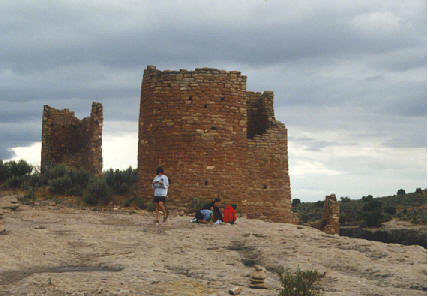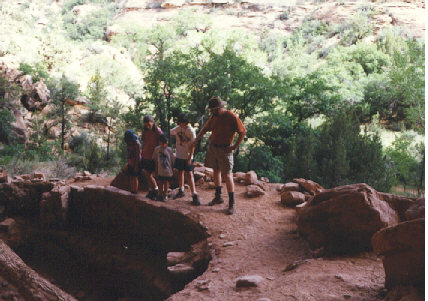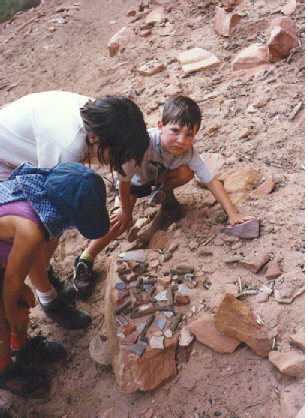
The Ancient Peoples of North America have fascinated me ever since I found an Indian axehead on a Cub Scout outing. On this vacation I discovered the evidence of their civilizations is far more extensive than I suspected, especially in the Four Corners region of the southwest. We had visited Mesa Verde on a previous vacation so this time we got off the beaten path. Literally. The Utah road crews were ripping up the dirt roads to lay paved ones and we discovered they don't construct temporary roads first - you just drive through their mess. The tower on the left is at Hovenweep. It is impressive, but roped off. In spite of the small number of visitors I still had the impression we were in a museum.
After spending the night in Blanding, Utah, we drove to the Kane Ranger station and loaded up our packs. 1997 was the last year for simply registering and hiking in since entry is now limited to those chosen by lottery. I learned of Grand Gulch by reading the fascinating book "In Search of the Old Ones" by David Roberts (
1996, Simon & Schuster). His book and several accounts on the Internet warned of heat and dehydration so we stocked up on $20 Platypus canteens (you put them in your pack and suck out water through a tube) and struck out into the canyon. Sure enough, it was hot. The canyon started as a wash and began to get deeper and steeper, though we never had any trouble with the trail (at this point, anyway).

As an incentive to the kids we promised an ice cream sundae to the first one to spot an Anasazi ruin. Becca won. It was Junction Ruin and had dwellings at the base of the cliff and up high. In all, we saw about seven villages or groupings of dwellings in ten miles of hiking the canyon. The one on the left is in Todie Canyon, and below is a collapsed kiva, I think at Turkey Pen Ruin.


On the left are some storage rooms at Junction Ruin. It was hard to believe they had been abandoned almost 750 years ago because they looked pristine. We made sure the kids (and parents) did not touch any of the dwellings or take any objects. Our goal was to leave the ruins just as we found them.
Below, we investigate some potsherds and corn cobs displayed by other visitors. Some find this objectionable but we enjoyed looking at them and it eliminated any temptation to find our own. The differing styles of pottery was very interesting.
They are not actually touching the Anasazi hand prints. We found the rock art to be as fascinating as the architecture. It gave a very mysterious air to the canyon. It was also surprisingly sparse when you consider they lived here for centuries.

